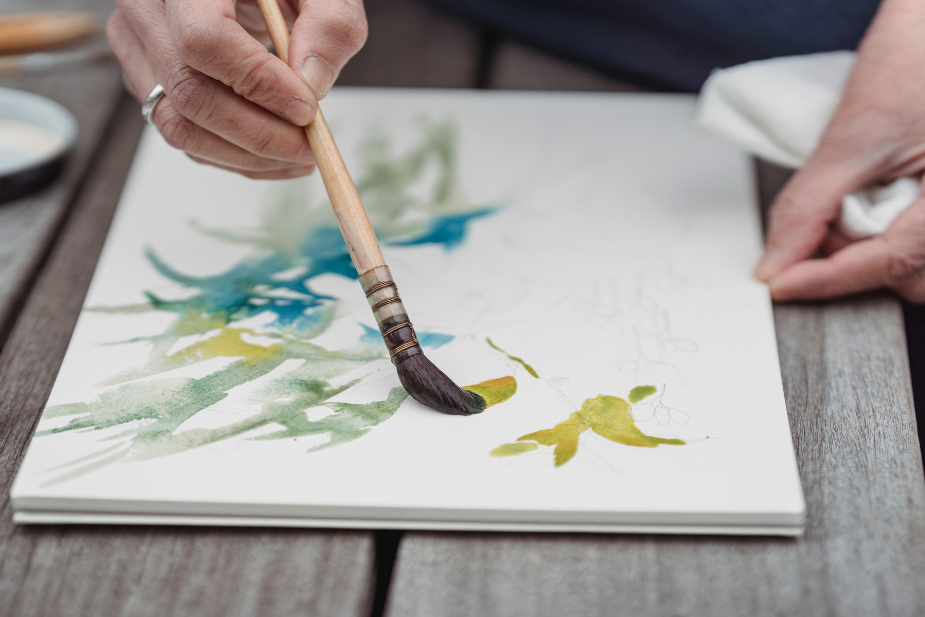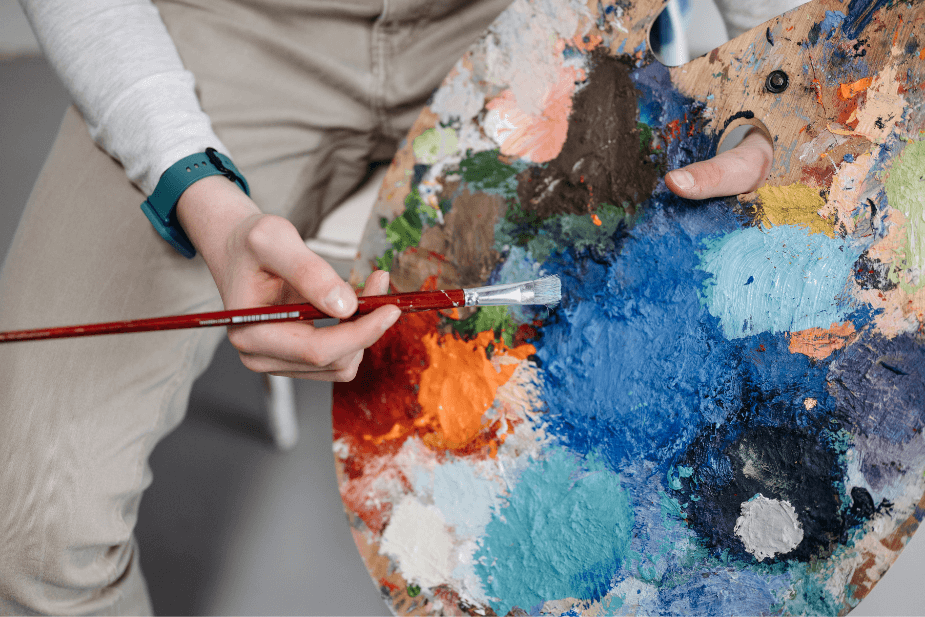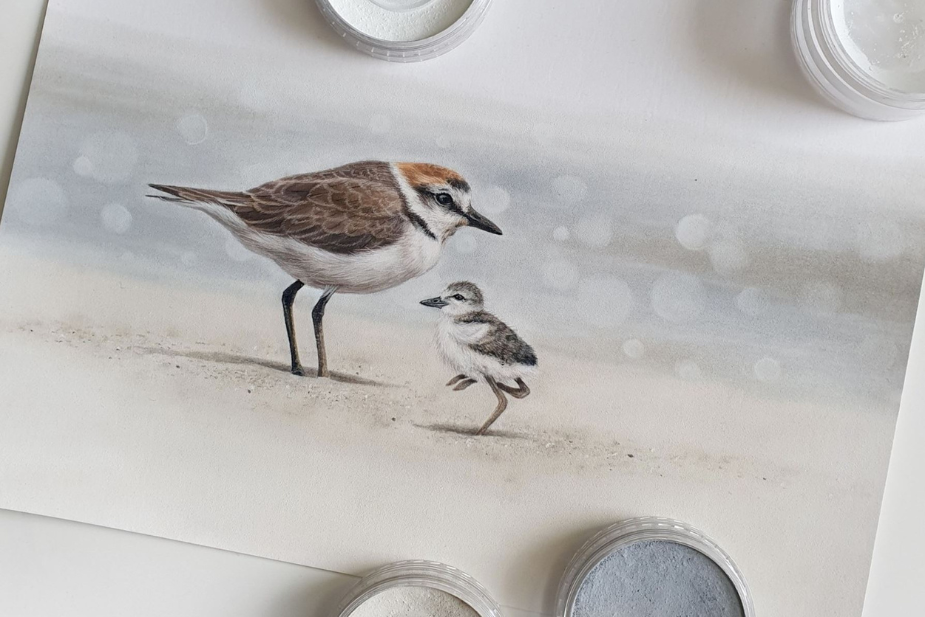
Watercolor Painting
Watercolour paints are produced in the same way as any other paint: colour pigments, which can be naturally occurring or synthetically produced, are combined with a binder and possibly a series of additives, which are added in part to extend the life of the paint. Often the binder in modern watercolour paints is a mixture of gum arabic, water, glycerine and a complex carbohydrate such as honey or sugar syrup.
Gum Arabic is a naturally occurring material extracted from the acacia tree. Gum Arabic is added to reduce surface tension and it would not be wrong to see it as a form of water soluble glue that ensures the pigments bond to the material it is applied to. The remaining ingredients of the binder are added to soften the watercolour paint so that it is easy to work with and dissolves easily in water.
If you are in the position of judging the quality of a given watercolour paint, one obvious difference will be the size of the individual grains of pigment and as is so often the case in life, bigger is simply better.
Another important difference is the quality of the binder; if the binder works as it should, it is absorbed by the paper, which on the one hand increases the ability of the pigments to adhere to the paper, but the opposite effect is equally enabled: that is, the paint can be easily "lifted" off the paper again because it "sits on top" of the binder as opposed to penetrating the paper. Finally, the binder protects against the tendency of pigments to flocculation, i.e. clumping together.
The last important characteristic of quality watercolour paint is high light fastness. The word is a bit misleading, as it is an expression of the durability of watercolour paint: that is, how much light a work made with the colours of this medium can withstand before it ages and is damaged. There is even a scale of lightfastness that goes from I to IV, with I being the best and IV being the worst.
So a high light fastness means you have less to worry about your work ageing and damaging over time. Low light fastness was a big problem in the past, partly due to the use of many synthetic pigments, which were often unstable and of low quality.
Watercolours are often combined with other media, what is called mixed mediaas the artist can bypass the limitations of one medium or combine the effects of several. Historically, watercolour painting has often been combined with its more opaque sibling, gouache, which often goes by the names bodycolor, opaque watercolour or poster colour.
Gouache has a much higher pigment-to-binder ratio than watercolour and thickened gouache can be used tactilely, that is, to create an uneven surface that can be felt by touch. You can read much more about gouache here.
Special properties
One unique characteristic of watercolour paint is that the paint does not form a continuous layer as we know it from acrylic and oil paint. Instead, colour pigments are spread randomly over the surface of the paper at a microscopic level.
However, watercolour paint is best known for its transparency and traditionally the understanding has been that the colours have great brightness and intensity because they act like a layer of coloured glass over the paper, allowing light to penetrate through the pigment down onto the paper and subsequently be reflected from the paper back up through the pigment. Unfortunately, this is a misconception.
The transparency in watercolour painting occurs because the paper is visible under the pigment particles and the intensity of the colours is instead explained by the pigments being applied in a purer form and with fewer fillers (such as kaolin, which tends to whiten paint).
Since watercolour paint belongs to the family of water-based media, one key condition for using the medium is that the water evaporates quickly. This results in a drying time that is much faster than is the case for many other types of paint. Conversely, there are watercolour paints that can be reactivated by the addition of water and even lifted off the paper, so the fast drying time is not automatically a limitation.
It is, if not impossible, at least very difficult not to focus on watercolour paper and paper in general when we talk about watercolour painting. Shiny white paper helps to create the almost gem-like effect of the colours, and for the same reason watercolours are not usually painted on coloured paper.
The recipe for good watercolour paper requires, first of all, that the paper be acid-free. This is because the acid in the paper can react with the colours and potentially damage or change the lightness of the colour.
The next important aspect of paper selection is the surface texture of the paper. Stelling watercolour paper is available in three textures: fine, coarse and rough. The three different types of watercolour paper soak up the watercolour paint differently, so it will often be a matter of taste which one you like working on best.
Watercolour paper is traditionally treated with thickeners, called appreturants, to make it less absorbent, so paint doesn't seep through to underlying sheets and to allow brushstrokes to be more precise. Historically this was gelatine, but other thickeners are also used.
Conversely, if you want an effect where the paper almost soaks up paint, the paper can be wetted before use, or you can buy special paper that has not been treated with a finishing agent as is the case with traditional Japanese paper, for example.
The story behind
From the ancient Egyptians with their papyrus to the Chinese who invented modern paper almost 2,000 years ago. The development and use of watercolour painting has gone hand in hand with that of paper from ancient times to the present day.
Although it took some time, paper also made its appearance in Europe from around 1200, but it was in fresco painting - also known as fresco painting, where pigments and water are mixed with wet plaster - that watercolours first made their mark on the continent.
At the same time as the most famous frescoes ever produced for the Sistine Chapel in the early years of the 16th century, the German Albrecht Dürer began to produce iconic works of animals and plants in watercolour. Dürer's influence was to be enormous and his work was instrumental in the creation of Europe's first school of watercolour painting.
Until the 18th century, watercolour painting was mixed by the artist or the artist's assistants. The pigments themselves were bought from apothecaries or specialist paint dealers and were then combined with gum arabic or other binders.
The first commercially available products were difficult to use, but in 1781 the British colourist Thomas Reeves and his brother invented the paint-cake. The "cake" of paint was easily soluble in water and the time saved and ease of use led to the great revival of watercolour art in England during the same period.
Over time, advances in industrial organic chemistry enabled the range, colourfulness and, not least, durability of watercolour paint to improve enormously. A contemporary example of these achievements is the QoR (Quality of Results) line from GOLDEN, which uses the patented Aquazol-binder instead of gum arabic. Aquazol is best known for its use among conservators, where it is preferred because it possesses tremendous light fastness while being very safe to use and odorless.
That said, it is always a good idea to look at whether the right fixative can further prolong and protect your work.
Classifications
Artist
"Artist" is each manufacturer's most exclusive and most expensive grade of watercolor paint. The quality is characterised by enormously high reliability - both in terms of stability and durability - as well as how colourfast it is. In addition, the Artist series contains an enormous amount of colour pigments and some absolutely fantastic binders.
In the Artist series, products will typically be priced according to how expensive each colour pigment may be.
Studio
"Studio", or "student" as it is also sometimes known, is a cheaper class classification than "Artist" and the conventional wisdom is that these affordable alternatives can be used during the preparation of studio works and/or in learning situations where a lot of watercolour paint needs to be flung onto a canvas in a hurry and it would be too costly to use Artist.
So even though it's a cheaper product with fewer pigments and a less good binder, you can still use Studio quality watercolours for your finished works - even as a professional artist. It's just important to be aware that it's a different and lower quality.
As is the case with the "big brother", not all pigments are born equal. You will therefore sometimes find that products in the Studio ranges have a different amount of colour pigment in them, as well as selected colours not being available in Studio quality at all, as the pigments are simply too expensive for a more affordable range. These exotic or rare colour pigments are replaced by cheaper alternatives - so-called hues, which are confusingly similar but in some cases have altered properties due to the choice of pigments from other pigment families.
Variants
Modern watercolour paints are available in tubes, in so-called pans and in liquid form.
In tubes, the consistency is like toothpaste, because the paint is already mixed with a little water. Adding more water gives the watercolour paint the liquid consistency you know and love.
Benefits of tube:
- Easy to control and adjust the amount of paint
- Particularly suitable for works where you need a lot of one colour
- Can be applied to a palette where they can dry out like pans and rehydrated for use
- Formulated to mix easily
Disadvantages of tube:
- Can dry out if tube is not closed properly
- Lid can stick
In pans, paint comes in small, dried bars of paint in an enclosing plastic container that "snaps" into place in watercolor boxes. These act a bit like Thomas Reeves' famous "cakes" and come in two sizes, half and whole pans.
Advantages of pans:
- Easy to carry around in a watercolour box and ready to use straight away
- Used or unwanted pans can be removed and replaced, or you can buy one empty box and put together your own palette of watercolour paints
- You have a carefully selected range of colours or shades and this limitation can make it easier to get started
Disadvantages of pans:
- Tendency to muddy colours
- It can be harder to use a larger brush if you don't transfer your watercolour paint to a palette, but instead paint straight from the box
- Wears more on your brushes
Liquid watercolour paint is a highly concentrated water medium sold in small and large bottles. They can be used undiluted, but many users like to dilute them 1:1 with water. Liquid watercolour paints can be a good choice if you want very vivid and rich colours.
Advantages of liquid:
- Enormous colour intensity
- Concentrated colour that is very slow to use
- Suitable for use in calligraphy pens and in airbrush
Disadvantages of liquid:
- Tendency to lower light fastness
- Can become gritty if ink is rehydrated after drying
- Tendency to discolour palette
In Stelling we also carry watercolour pencils as well as -markers.
Why choose watercolour over acrylic paint
Watercolours dry even faster than acrylics, but they are nevertheless much more suitable for outdoor use, or in situations where it's very hot, for example. In these conditions, acrylic paints tend to dry out very quickly.
The two media have quite different learning curves. While most of us are introduced to watercolours as children, acrylics are often considered more of a hobby or art product, but it is actually acrylics that are much easier to learn to use. Conversely, watercolour paint has such depth that although it can be difficult to master, it is also one of the most satisfying mediums to use once you have invested the time in it.
One aspect that is less of an advantage and more an expression of aesthetic choice is watercolor's tendency to create less realistic and more airy and fluid works than is the case with acrylic and oil paintings. For the same reason, it can be a good idea to combine media. The opacity and water resistance of acrylic paint can complement the dreamy qualities of watercolour.
Why choose watercolour over oil paint
There can be little doubt that watercolour painting is less laborious and much easier to approach than oil painting. You don't have to worry about solvents, the paint dries quickly - both on paper and in a box or palette - and cleaning brushes and work areas requires nothing more than water and maybe a little brush soap. For the same reason, many artists over the years have liked to prepare quick studies in watercolour and then finish their pictures in oil.
As already described, watercolour painting lends itself very well to mixed media, where two or more media are combined in the same work. Oil paint can also technically be used on top of, for example, acrylic, but this is not a strength of the medium in the same way as is the case for watercolour.
Watercolour painting is considered to be a direct medium because there is no time for hesitation in the process and where oil painting needs to be controlled and manipulated, watercolour painting is about placing each brush stroke and letting the magic take over. Over time, of course, the artist gets better at anticipating the chemistry that plays out on the paper between wet and dry materials, but watercolor will always behave unpredictably.
Finally, there's the material you're working on top of. If you prefer to paint on paper, then watercolour paint is simply the natural choice.
At Stelling, we're always happy to help, so drop us a line if you need advice or guidance for your next oil painting project.



